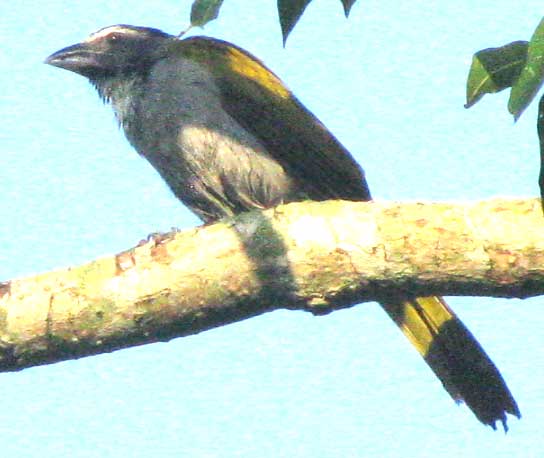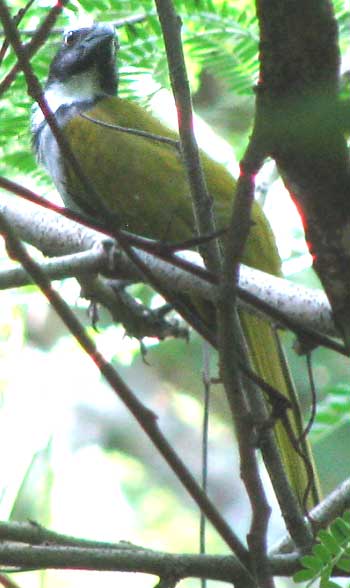Excerpts from Jim Conrad's
Naturalist Newsletter

from the March 7, 2010 Newsletter issued from Hacienda Chichen Resort beside Chichén Itzá Ruins, central Yucatán, MÉXICO
GUAVA-EATING SALTATORS
Next to Hacienda Chichen's office entrance a Guava tree is producing ripe guavas, which many birds love, especially the Black-headed Saltators, SALTATOR ATRICEPS. When I sat on the steps to wait for someone it wasn't five minutes before the saltators' passion for guavas overcame their nervousness about visiting the tree only about ten feet from me. You can see one of the birds, his throat feathers wet from ripe guava, above.
A saltator would gorge himself about half a minute, then another would fly onto a branch nearby, and complain loudly with sharp, squeaky sounds a little like a wet hand rubbing a wet balloon, CHEUK! CHEUK! CHEUK! Before long the visitor couldn't stand it any longer, would hop down and drive the other away, and then before long yet another would come with the same calls and finally displace the eater after he'd gorged awhile.
Howell in his A Guide to the Birds of Mexico and Northern Central America describes saltators as a group as "fairly plain tropical grosbeaks of forest edge and second growth." With its short, thick bill you know that it must be in the same family as sparrows, towhees and grassquits. However, being larger birds and with more massive bills, they're in a different subfamily, the Cardinalinae.
Black-headed Saltators are fairly common residents from central eastern Mexico to Panama.
from the March 7, 2010 Newsletter issued from Hacienda Chichen Resort beside Chichén Itzá Ruins, central Yucatán, MÉXICO
SALTATOR IMMATURE PLUMAGES
Once the above picture of the Black-headed Saltator was on my screen I got the impression that we had a youngish bird not quite yet with a fully developed adult plumage. The black rim around the bird's white throat as well as the black face weren't black and sharply defined enough, and the white eye stripe wasn't bold and well defined enough. Also, there was a hint of the stripe passing well beyond the eye. That latter detail made me call up the photo shown below:

That photo, taken two months ago, struck me then as probably an immature Grayish Saltator because the eye stripe, or supercilium, passed way beyond the eye instead of curling around the eye's top as a Black- headed Saltator's does. However, I had my doubts about it being a Grayish because of the hint of a black rim around the white throat, which Grayish Saltators aren't supposed to have. Now I'm thinking that instead of an immature Grayish it may have been an immature Black-headed Saltator.
Here we're dealing with issues that aren't made clear in generally available sources. I'm tickled to contribute these field notes for others also struggling to master such issues as the saltators' various immature plumages. Now when anyone Googles the keywords "saltator immature plumages" they'll find this link near the top of their page.
from the March 3, 2008 Newsletter issued from Mexico's Southernmost State, CHIAPAS
SALTATORS

These mornings if you walk on the tree-shaded dirt trail down between the irrigated cornfields and pastures or wander the fire-ravaged, scrubby slopes and woods edges, one bird seems to be making more noise than all the others. "Noise" isn't a nice way to describe a birdcall that must constitute heartfelt and lucid communication to the bird, but if you'd hear it you'd understand.
Typically the calls are of two qualities. The noisiest is a loud, sharp, smacking or squeaking sound like what you get screwing the palm of your hand over a wet balloon -- CHOWK! or CHEUK! The other sound is a "gruff, accelerating, rolling laugh or chortling chatter," as Howell describes it. If you're bird-listening more than bird-watching you get the impression that the most conspicuous bird around here is the one making these sounds. The birds are saltators -- Black-headed Saltators, SALTATOR ATRICEPS, to be exact.
Thinking in terms of taxonomic affinities, Howell describes saltators as "fairly plain tropical grosbeaks of forest edge and second growth." Genetically they almost may be grosbeaks, but their beaks aren't nearly as oversized-looking at those of Rose-breasted or Evening Grosbeaks. To me saltators possess the size, shape and beak dimensions of towhees more than grosbeaks.
Mexico is home to three saltator species but around here I've only seen the Black-headed one, which is distributed from Mexico's central Gulf lowlands south to Panama. Our Black-headed species is easy to identify because it looks like a pea-green-backed, gray breasted towhee with a black head, and with a diamond-shaped, white throat-patch completely surrounded by a black border. Typically three to five birds fly around excitedly smacking and chortling.